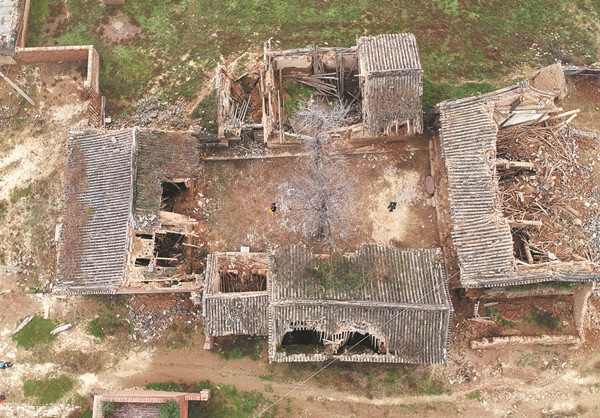Storms take their toll on heritage in Shanxi
Updated: 2021-11-02

A partly collapsed Ming Dynasty courtyard in Xiawang village, Pingyao, Shanxi. [Photo by Zou Hong/China Daily]
Pingyao, which was built 2,700 years ago, had major facelifts during the Ming Dynasty (1368-1644) and the Qing Dynasty (1644-1911). Arguably China's best-preserved walled city, it was inscribed on the UNESCO World Heritage List in 1997.
The city walls in Pingyao, which span more than 6,100 meters, were built in the Ming Dynasty according to traditions at that time-the outer parts were built of bricks, while the inner were made from rammed earth.
According to the Pingyao City Wall Protection Office, 15 inner wall sections had been damaged as of Oct 19, with rammed earth subsiding at 36 locations.
In 2004, Ren Yimin, a cultural relics expert, led a team to restore the city wall. Since then, he has overseen repairs and renovations to the structure.
"Water poses the greatest threat to rammed earth, which comprises much of the city wall," said Ren, dean of the Shanxi Provincial Conservation Research Institute of Ancient Buildings, Colored Sculptures and Murals.
"We were hit hard by the torrential rain this year, but the wall is at risk of collapsing during the rainy season every year. Different parts of the wall have been repaired over the years," he added.
Shao said the sections of the wall he restored in the past 10 years were not damaged in the recent rainfall. "My colleagues and I put up more than 200 plastic sheets on different parts of those sections that might be in danger," he added.
During the rainfall, patrol teams worked day and night to inspect the wall, with a team of two allocated for each section, Shao added.
Pingyao residents appreciate the efforts made by Shao and his colleagues to renovate and strengthen the ramparts, believing that the wall is sufficiently safe even though it is high and close to their homes.
Guo Dianhua, 72, whose family has lived for five generations in Pingyao, said that although some sections collapsed, she thought the inner parts of the wall would stand firm, as they have for centuries.
"The rain was very heavy, streaming down the roofs for several days and nights," she said, adding that in addition to the ramparts, she was worried about the roof at her house. Some parts of the roof were washed away by the storms, and she used loosely packed cement to fill the cracks.



